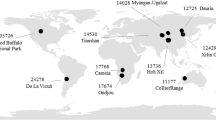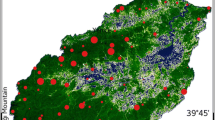Abstract
The ‘spectral variation hypothesis (SVH)’ assumes spectral variability as a result of variation in species richness. In the present study, we explore the potential of satellite datasets in identifying the patterns in species richness in part of three global biodiversity hotspots falling in India viz., Himalaya, Indo-Burma, and Western Ghats. We used generalized linear models to correlate remote sensing based vegetation indices (VIs) and physiographic indices (PIs) with plant richness calculated using 1264, 1114, and 1004 field plots across 21 different forest vegetation classes in Himalaya, Indo-Burma, and Western Ghats respectively. Three different vegetation indices ranked highest in explaining the variance in plant richness in the three hotspots. The variance in species richness explained by models based on only VIs was highest (69%, P < 0.01) for Bamboo vegetation in Indo Burma hotspot with Normalized Difference Vegetation Index, followed by that for dry deciduous forest in Western Ghats (57%, P < 0.001) with Normalized Difference Water Index, and for grasslands (54%, P < 0.05) in Himalaya by Modified Soil Adjusted Vegetation Index. The explained variance increased with combined models that are based on PIs and VIs to up to 85% (P < 0.05). Overall, we observed very high correlation between VIs and plant richness in open canopy vegetation classes with low species richness such as grasslands, scrubs, and dry deciduous forests, followed by vegetation classes with moderately dense canopy. Our study provides crucial insights on utility of satellite datasets as a proxy for estimating plant richness for better conservation of diverse ecosystems.





Similar content being viewed by others
References
Austin GE, Thomas CJ, Houston DC, Thompson DB (1996) Predicting the spatial distribution of buzzard Buteo buteo nesting areas using a Geographical Information System and remote sensing. J Appl Ecol 33:1541–1550
Carlson KM, Asner GP, Hughes RF, Ostertag R, Martin RE (2007) Hyperspectral remote sensing of canopy biodiversity in Hawaiian lowland rainforests. Ecosystems 10(4):536–549
Cayuela L, Golicher DJ, Benayas JMR, González-Espinosa M, Ramírez N (2006) Fragmentation, disturbance and tree diversity conservation in tropical montane forests. J Appl Ecol 43(6):1172–1181
Currie DJ (1991) Energy and large-scale patterns of animal-and plant-species richness. Am Nat 137(1):27–49
Duro DC, Coops NC, Wulder MA, Han T (2007) Development of a large area biodiversity monitoring system driven by remote sensing. Prog Phys Geogr 31(3):235–260
Fairbanks DH, McGwire KC (2004) Patterns of floristic richness in vegetation communities of California: regional scale analysis with multi-temporal NDVI. Glob Ecol Biogeogr 13(3):221–235
Foody GM (2004) Sub-pixel methods in remote sensing Remote sensing image analysis: including the spatial domain. Springer, New York, pp 37–49
Gaitán JJ, Bran D, Oliva G, Ciari G, Nakamatsu V, Salomone J (2013) Evaluating the performance of multiple remote sensing indices to predict the spatial variability of ecosystem structure and functioning in Patagonian steppes. Ecol Ind 34:181–191
Gao B (1996) NDWI—a normalized difference water index for remote sensing of vegetation liquid water from space. Remote Sens Environ 58(3):257–266
Gillespie TW (2005) Predicting woody-plant species richness in tropical dry forests: a case study from south Florida, USA. Ecol Appl 15(1):27–37
Gillespie TW, Foody GM, Rocchini D, Giorgi AP, Saatchi S (2008) Measuring and modelling biodiversity from space. Prog Phys Geogr 32(2):203–221
Gould W (2000) Remote sensing of vegetation, plant species richness, and regional biodiversity hotspots. Ecol Appl 10(6):1861–1870
Levin N, Shmida A, Levanoni O, Tamari H, Kark S (2007) Predicting mountain plant richness and rarity from space using satellite-derived vegetation indices. Divers Distrib 13(6):692–703
Myers N, Mittermeier RA, Mittermeier CG, Da Fonseca GA, Kent J (2000) Biodiversity hotspots for conservation priorities. Nature 403(6772):853
Nagendra H (2001) Using remote sensing to assess biodiversity. Int J Remote Sens 22(12):2377–2400
Nagendra H, Rocchini D, Ghate R, Sharma B, Pareeth S (2010) Assessing plant diversity in a dry tropical forest: comparing the utility of Landsat and IKONOS satellite images. Remote Sens 2(2):478–496
O’brien EM, Field R, Whittaker RJ (2000) Climatic gradients in woody plant (tree and shrub) diversity: water-energy dynamics, residual variation, and topography. Oikos 89(3):588–600
Oindo BO, Skidmore AK (2002) Interannual variability of NDVI and species richness in Kenya. Int J Remote Sens 23(2):285–298
Öster M, Cousins SA, Eriksson O (2007) Size and heterogeneity rather than landscape context determine plant species richness in semi-natural grasslands. J Veg Sci 18(6):859–868
Pau S, Gillespie TW, Wolkovich EM (2012) Dissecting NDVI–species richness relationships in Hawaiian dry forests. J Biogeogr 39(9):1678–1686
Pausas JG (1994) Species richness patterns in the understorey of Pyrenean Pinus sylvestris forest. J Veg Sci 5(4):517–524
Pouteau R, Gillespie TW, Birnbaum P (2018) Predicting tropical tree species richness from Normalized Difference Vegetation Index time series: the devil is perhaps not in the detail. Remote Sens 10(5):698
Qi J, Chehbouni A, Huete A, Kerr Y, Sorooshian S (1994) A modified soil adjusted vegetation index. Remote Sens Environ 48(2):119–126
R Development Core Team (2014) R: a language and environment for statistical computing. R Foundation for Statistical Computing, Vienna, Austria. http://www.R-project.org
Rocchini D (2007) Effects of spatial and spectral resolution in estimating ecosystem α-diversity by satellite imagery. Remote Sens Environ 111(4):423–434
Rocchini D, Ricotta C, Chiarucci A (2007) Using satellite imagery to assess plant species richness: the role of multispectral systems. Appl Veg Sci 10(3):325–331
Rocchini D, Petras V, Petrasova A, Horning N, Furtkevicova L, Neteler M (2017) Open data and open source for remote sensing training in ecology. Ecol Inform 40:57–61
Roy P, Karnatak H, Kushwaha S, Roy A, Saran S (2012) India’s plant diversity database at landscape level on geospatial platform: prospects and utility in today’s changing climate. Curr Sci (Bangalore) 102(8):1136–1142
Roy PS, Behera MD, Murthy M, Roy A, Singh S, Kushwaha S (2015) New vegetation type map of India prepared using satellite remote sensing: comparison with global vegetation maps and utilities. Int J Appl Earth Obs Geoinf 39:142–159
Schwarz M, Zimmermann NE (2005) A new GLM-based method for mapping tree cover continuous fields using regional MODIS reflectance data. Remote Sens Environ 95(4):428–443
Simpson EH (1949) Measurement of diversity. Nature 163:688
Tripathi P, Behera MD, Roy PS (2017) Optimized grid representation of plant species richness in India—Utility of an existing national database in integrated ecological analysis. PloS one 12(3):e0173774
Viedma O, Torres I, Pérez B, Moreno JM (2012) Modeling plant species richness using reflectance and texture data derived from QuickBird in a recently burned area of Central Spain. Remote Sens Environ 119:208–221
Willis KJ, Whittaker RJ (2002) Species diversity-scale matters. Science 295(5558):1245–1248
Acknowledgements
The authors are thankful to Dr. PS Roy, Project Director, Biodiversity Characterization project for providing the field sampling data for this study.
Disclaimer
The views and interpretations in this publication are those of the authors and are not necessarily attributable to ICIMOD.
Author information
Authors and Affiliations
Corresponding author
Additional information
Communicated by M.D. Behera, S.K. Behera and S. Sharma.
Publisher's Note
Springer Nature remains neutral with regard to jurisdictional claims in published maps and institutional affiliations.
Electronic supplementary material
Below is the link to the electronic supplementary material.
Rights and permissions
About this article
Cite this article
Chitale, V.S., Behera, M.D. & Roy, P.S. Deciphering plant richness using satellite remote sensing: a study from three biodiversity hotspots. Biodivers Conserv 28, 2183–2196 (2019). https://doi.org/10.1007/s10531-019-01761-4
Received:
Revised:
Accepted:
Published:
Issue Date:
DOI: https://doi.org/10.1007/s10531-019-01761-4




